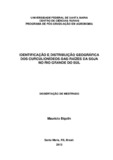| dc.creator | Bigolin, Mauricio | |
| dc.date.accessioned | 2017-05-12 | |
| dc.date.available | 2017-05-12 | |
| dc.date.issued | 2013-02-19 | |
| dc.identifier.citation | BIGOLIN, Mauricio. Identification and geographical distribution of soybean roots weevils in Rio Grande do Sul. 2013. 71 f. Dissertação (Mestrado em Agronomia) - Universidade Federal de Santa Maria, Santa Maria, 2013. | por |
| dc.identifier.uri | http://repositorio.ufsm.br/handle/1/5074 | |
| dc.description.abstract | The occurrence of root weevils in the systems of production of soybeans has
shown a significant increase in the southern region of the country in the last decade,
however, there is little information about the species, its distribution and damage of
this group of insects in soybeans. This study aimed to identify the species of root
weevils associated with soybean, to study geographical distribution and develop an
identification key of species of adult root weevils in Rio Grande do Sul. The survey of
the occurrence and geographical distribution of root weevils was conducted in
commercial soybean plantations of 55 municipalities of Rio Grande do Sul, during the
agricultural harvest 2011/12. In each location / municipality, 15 points per farming
were sampled, using the sampling method of insect net. The collected samples were
placed in plastic containers containing 70% alcohol and sent to the laboratory, for
later identification, quantification and assembly of entomological collection. After the
identification, the occurrence of 12 species of weevils roots associated with soybean
in RS was recorded, belonging to four genera. The genus Naupactus had the highest
number of insects, totaling 9 species. Naupactus cervinus was the species that
occurred in more locations, being found in 22 municipalities in the RS, distributed in
all regions of leguminous production in the state. The species of root weevils
presented in the key of identification are: Aramigus conirostris (Hustache),
Atrichonotus sordidus (Hustache), Naupactus alternevittattus Hustache, Naupactus
ambiguus Boheman, Naupactus cervinus Boheman, Naupactus cinerosus Boheman,
Naupactus leucoloma Boheman, Naupactus minor (Buchanan), Naupactus
peregrinus Buchanan, Naupactus purpureoviolaceus Hustache, Naupactus
tremolerasi Hustache and Pantomorus viridisquamosus (Boheman). | eng |
| dc.description.sponsorship | Coordenação de Aperfeiçoamento de Pessoal de Nível Superior | |
| dc.format | application/pdf | por |
| dc.language | por | por |
| dc.publisher | Universidade Federal de Santa Maria | por |
| dc.rights | Acesso Aberto | por |
| dc.subject | Chave taxonômica | por |
| dc.subject | Insetos de solo | por |
| dc.subject | Naupactus sp. | por |
| dc.subject | Pragas da soja | por |
| dc.subject | Taxonomic key | eng |
| dc.subject | Soil insects | eng |
| dc.subject | Soybeans pests | eng |
| dc.title | Identificação e distribuição geográfica dos curculionídeos-das-raízes da soja no Rio Grande do Sul | por |
| dc.title.alternative | Identification and geographical distribution of soybean roots weevils in Rio Grande do Sul | eng |
| dc.type | Dissertação | por |
| dc.description.resumo | A ocorrência de curculionídeos-das-raízes nos sistemas de produção de
grãos de soja, na região sul do País, vem apresentando um aumento expressivo na
última década, no entanto, há poucas informações sobre as espécies, sua
distribuição e danos desse grupo de insetos na cultura da soja. Este trabalho teve
por objetivo identificar as espécies de curculionídeos-das-raízes associados à
cultura da soja, estudar sua distribuição geográfica e elaborar uma chave de
identificação das espécies de curculionídeoes-das-raízes adultos para o Rio Grande
do Sul. O levantamento da ocorrência e distribuição geográfica de curculionídeosdas-
raízes foi realizado em lavouras comerciais de soja de 55 municípios do Rio
Grande do Sul, durante a safra agrícola 2011/12. Em cada local/município foram
amostrados 15 pontos por lavoura, utilizando o método de amostragem da rede
entomológica. Os exemplares coletados, foram acondicionados em potes plásticos
contendo álcool 70% e encaminhados ao laboratório para posterior identificação,
quantificação e montagem da coleção entomológica. Após a identificação foi
registrada a ocorrência de 12 espécies de curculionídeos-das-raízes, pertencentes a
quatro gêneros, associados à cultura da soja no RS. O gênero Naupactus apresenta
o maior número de insetos, totalizando nove espécies. Naupactus cervinus é à
espécie que ocorre em maior número de locais, sendo encontrada em 22 municípios
do RS, distribuídos em todas as regiões produtoras da leguminosa no estado. As
espécies de curculionídeos-das-raízes presentes na chave de identificação são:
Aramigus conirostris (Hustache), Atrichonotus sordidus (Hustache), Naupactus
alternevittattus Hustache, Naupactus ambiguus Boheman, Naupactus cervinus
Boheman, Naupactus cinerosus Boheman, Naupactus leucoloma Boheman,
Naupactus minor (Buchanan), Naupactus peregrinus Buchanan, Naupactus
purpureoviolaceus Hustache, Naupactus tremolerasi Hustache e Pantomorus
viridisquamosus (Boheman). | por |
| dc.contributor.advisor1 | Guedes, Jerson Carus | |
| dc.contributor.advisor1Lattes | http://lattes.cnpq.br/0846418627719511 | por |
| dc.contributor.referee1 | Costa, Ervandil Corrêa | |
| dc.contributor.referee1Lattes | http://lattes.cnpq.br/5146228842979896 | por |
| dc.contributor.referee2 | Jacques, Rodrigo Josemar Seminoti | |
| dc.creator.Lattes | http://lattes.cnpq.br/0315871412493082 | por |
| dc.publisher.country | BR | por |
| dc.publisher.department | Agronomia | por |
| dc.publisher.initials | UFSM | por |
| dc.publisher.program | Programa de Pós-Graduação em Agronomia | por |
| dc.subject.cnpq | CNPQ::CIENCIAS AGRARIAS::AGRONOMIA | por |


